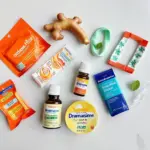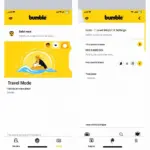Picture this: you’re at the airport, about to jet off to Bali after months of meticulous planning. You can practically taste the mango sticky rice and feel the warm sand between your toes. Suddenly, you remember that bottle of sunscreen in your carry-on bag. Is it too big? Panic sets in.
We’ve all been there. Navigating the TSA liquid rules can be a bit confusing, but don’t worry, we’ve got you covered. This guide will walk you through everything you need to know about liquid restrictions on airplanes, so you can breeze through security like a seasoned traveler.
Understanding the 3-1-1 Rule for Carry-On Liquids
The magic number to remember when it comes to liquids in your carry-on bag is 3-1-1, which translates to:
- 3.4 ounces (100 milliliters) per container: This is the maximum size container you can bring for liquids, gels, and aerosols.
- 1 quart-sized bag: All your eligible travel-sized liquids must fit into a single, clear, quart-sized zip-top bag.
- 1 bag per passenger: Each passenger is allowed one quart-sized bag of liquids.
Pro Tip: Invest in reusable, TSA-approved travel bottles. They are affordable, eco-friendly, and ensure you always stay within the limit.
What Counts as a Liquid?
You might be surprised by what falls under the “liquids rule.” Here are some common items:
- Beverages (water, juice, soda)
- Creams and lotions (sunscreen, moisturizer, toothpaste)
- Gels (hair gel, hand sanitizer)
- Aerosols (deodorant, hairspray)
- Pastes (toothpaste, peanut butter)
- Makeup (mascara, liquid eyeliner, foundation)
Did You Know? Solid makeup like powder blush or eyeshadow is not considered a liquid and doesn’t count towards your 3-1-1 allowance.
Exceptions to the Rule
There are a few exceptions to the 3-1-1 rule for essential items:
- Medications: You are allowed to bring medically necessary liquids in quantities larger than 3.4 ounces. Be prepared to declare these items to security personnel and provide supporting documentation if requested.
- Baby Formula and Food: Traveling with an infant? Formula, breast milk, and baby food are exempt from the standard liquid restrictions. However, it’s recommended to pack these items separately for easier screening.
- Duty-Free Purchases: Liquids purchased duty-free after security checkpoints don’t count toward your carry-on limit, as long as they are properly sealed in a tamper-evident bag with your receipt.
Packing Liquids in Checked Luggage
If you’re worried about fitting all your essentials into those tiny travel bottles, consider packing full-sized liquids in your checked baggage. There are no size restrictions for liquids in checked bags, but be aware that certain items, like flammable materials, may be prohibited. It’s always best to check with your airline for specific guidelines.
Travel Tip: Pack a small, empty reusable water bottle in your carry-on. You can fill it up after you pass through security, saving you money and reducing plastic waste.
Liquid Restrictions: FAQs
Q: Can I bring my own reusable water bottle through security?
A: Yes, but it must be empty when you go through security.
Q: What happens if my liquids exceed the allowed amount?
A: Security personnel may confiscate items that don’t comply with the regulations.
Q: Are there different liquid rules for international flights?
A: While most countries follow the 3-1-1 rule, it’s always wise to check with your airline or the destination country’s embassy for any specific regulations.
Pack Smart, Travel Smoothly
Remember, packing efficiently and adhering to airport security regulations will make your travel experience smoother and more enjoyable. By following the 3-1-1 rule and staying informed about any exceptions, you’ll be well-prepared to breeze through security and embark on your next adventure with ease.
For more helpful travel tips and information, check out these resources:
- What is the Travel Size Limit for Liquids?
- How to Pack a Backpack for Travel
- What to Pack for Airplane Travel
Safe travels!

